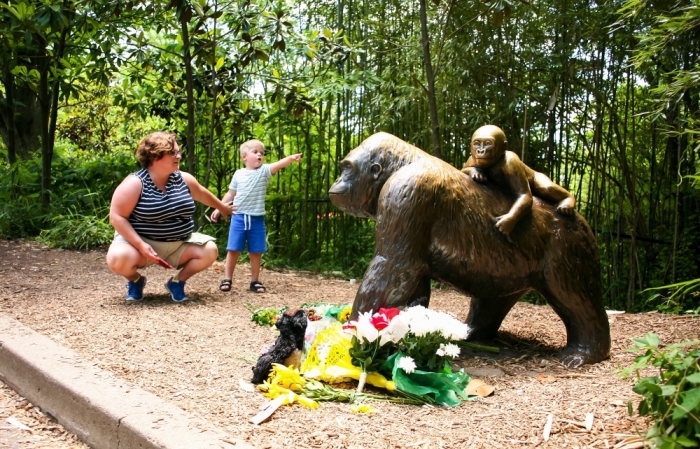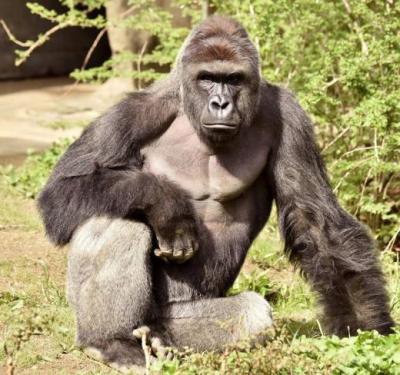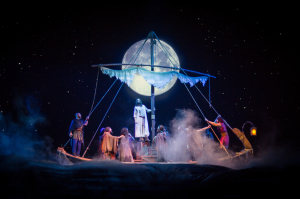Why We Grieve for the Gorilla That Could've Killed a Child

I confess, I am grieving for the gorilla.
To be precise: Harambe, the endangered western lowlands (perhaps) gallant gorilla into whose Cincinnati Zoo den a four-year old boy toppled on May 28.

We don't know if Harambe would prove gallant or not, because a bullet ended his life. The price of determining the ape's gallantry might have been too high — the mauling of a toddler.
Yet we really would like to know if the mighty animal with the noble eyes and stalwart countenance would have cared for the child. But how many of us would have waited to find out had it been our child in Harambe's clutches?
The whole episode awakens certain mystical memes that haunt us humans.
One thinks of Spock-logic in "The Wrath of Khan": "The needs of the many outweigh the needs of the one."
The meme appears in Churchill's speech after the small Royal Air Force beat the Nazi bombers in the Battle of Britain: "Never in the field of human conflict was so much owed by so many to so few."
Along with millions, I wanted Harambe to prove himself a friend. I wanted the child to be able to play at the feet of the mighty creature. We humans want to be able to trust a cobra to encircle us with a loving embrace, to frolic with great white sharks, for our toddlers to be able to stick their curious little fingers into the earthen hole that is the nest of a viper.
And we want very very much for there to be a warm and cozy moment when Harambe cuddles the child rather than tears him apart.
This is the world we really crave. In our heads we doubt its actuality, but in our hearts we feel it and yearn for it.
If we understand where the mystical memes come from we will understand why.
They are embedded in us because we are Imago Dei — made in the image of God. We not only have a body with its capabilities of interaction with the external material world, but a soul enabling thought and emotion, and choice. But as beings made in God's own image we also have a spirit that enables fellowship with the transcendent.

And it is in our human spirit that the meme of the one for the many nestles. Something deep inside us knows that the One will come and give Himself to redeem our lives from the pit. The Lamb slain from eternity enters the pit on a grim Friday afternoon and what the meme pointed to becomes actual in finite time and space.
We weep for Harambe but our tears are about something and Someone much greater. Strangely, though many of us would not admit it, the blood of the gorilla reminds us of the blood of the Lamb.
The wish for the befriending beast throbs in literature across history, and maybe even in pre-history in ancient cave art depicting scampering animals. It is the craving expressed in mythologies of numerous cultures. C.S. Lewis and his great lion, Aslan, present the meme powerfully. We feel the tug for fellowship with the tiger and the hyena in the "Life of Pi," but it doesn't come in the world of Pi.
Where do we get this universal desire for fellowship with the animals?
The Prophet Isaiah tells us:
And the wolf will dwell with the lamb,
And the leopard will lie down with the young goat,
And the calf and the young lion and the fatling together;
And a little boy will lead them.
Also the cow and the bear will graze,
Their young will lie down together,
And the lion will eat straw like the ox.
The nursing child will play by the hole of the cobra,
And the weaned child will put his hand on the viper's den.
They will not hurt or destroy in all My holy mountain,
For the earth will be full of the knowledge of the Lord
As the waters cover the sea.
(Isaiah 11:6-9)
We want this world so much we strive to rush the Kingdom. We earnestly try to make Harambe something he may not yet be, and labor to transform pits of artificial rock and faux-jungles into pristine gardens yet to come. We do it because the promise is inside us, said Jesus, and deep calls unto deep, wrote the Psalmist.
Maybe Carl Jung had it right. He said there were universal "archetypes," eternal symbols of greater realities in us all. Memes are the manifestations of those archetypes within human souls and cultures.
Some say it is the memory of Eden in our human DNA. But it is also the awareness of the coming of the New Eden when the Kingdom of Heaven merges with and overtakes this finite, flawed material kingdom.
The archetypes-memes are about realities that transcend us, and the memes within us tell us they are actual, that they came, are come, and are yet coming. They are the substance and evidence that is the solid reality on which our faith is based.
The King is coming, and the Kingdom in which we would know for certain that the little boy would be perfectly safe with the gorilla. As much as we want, we cannot rush the Kingdom. It will come in God's good time, according to His good purpose.
For now, rejoice that the child was saved, weep for the blood of the gorilla, and pray for the coming day when we will all be rescued from the pit.





























